Themed collection Luminescent Complexes and Materials for Light-Emitting Devices

Luminescent materials for solid-state lighting
Welcome to this Dalton Transactions themed issue on luminescent materials for solid-state lighting.

Dalton Trans., 2015,44, 8317-8317
https://doi.org/10.1039/C5DT90049B
Computational insights into the photodeactivation dynamics of phosphors for OLEDs: a perspective
In this perspective we highlight recent computational efforts to unravel competing photodeactivation mechanisms of radiative and non-radiative nature of phosphors.
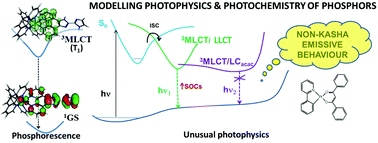
Dalton Trans., 2015,44, 8346-8355
https://doi.org/10.1039/C4DT03804E
Improving the carrier balance of light-emitting electrochemical cells based on ionic transition metal complexes
Improved carrier balance of a light-emitting electrochemical cell reduces exciton quenching near the doped layers, rendering a higher device efficiency.
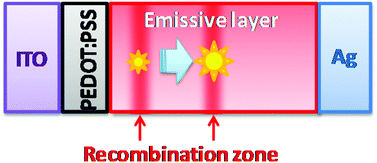
Dalton Trans., 2015,44, 8330-8345
https://doi.org/10.1039/C4DT01675K
FIrpic: archetypal blue phosphorescent emitter for electroluminescence
FIrpic is the most investigated bis-cyclometallated iridium complex. This Perspective reviews the main experimental and theoretical aspects of FIrpic as well as its use as sky-blue emitter for OLED.
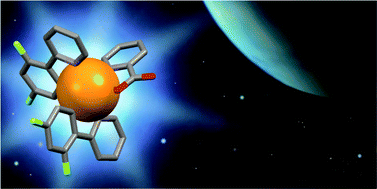
Dalton Trans., 2015,44, 8318-8329
https://doi.org/10.1039/C4DT02991G
Unusual near-white electroluminescence of light emitting diodes based on saddle-shaped porphyrins
In contrast to the red electroluminescence emission frequently observed in porphyrins based OLED devices, the present devices exhibit a nearly white emission with greenish yellow, yellowish green and blue green hues.

Dalton Trans., 2015,44, 8364-8368
https://doi.org/10.1039/C4DT03975K
Synthesis of dibenzothiophene-based host materials with a dimesitylborane substituent and their green PHOLED performances
Two structural isomers composed by linking between dibenzothiophene and dimesitylborane moieties on the phenyl group were synthesized and showed similar green device performance regardless of their different linkage positions.

Dalton Trans., 2015,44, 8360-8363
https://doi.org/10.1039/C4DT03700F
X-shaped benzoylbenzophenone derivatives with crossed donors and acceptors for highly efficient thermally activated delayed fluorescence
Thermally activated delayed fluorescence (TADF) materials based on benzoylbenzophenone, AcPmBPX and PxPmBPX, were designed and synthesized.

Dalton Trans., 2015,44, 8356-8359
https://doi.org/10.1039/C4DT03608E
Emissive Ir(III) complexes bearing thienylamido groups on a 1,10-phenanthroline scaffold
Highly emissive cyclometallated Ir(III) complexes bearing phenanthroline-based ancillary ligands are presented and the effect of tethered thiophene moieties on the photophysical properties is explored.

Dalton Trans., 2015,44, 16272-16279
https://doi.org/10.1039/C5DT02691A
C^C* cyclometalated platinum(II) N-heterocyclic carbene complexes with a sterically demanding β-diketonato ligand – synthesis, characterization and photophysical properties
New platinum(II) triazolylidene complexes were prepared to investigate the influence of the 1,3-bis(2,4,6-trimethyl)-phenylpropan-1,3-dionato ligand on the photoluminescence properties.
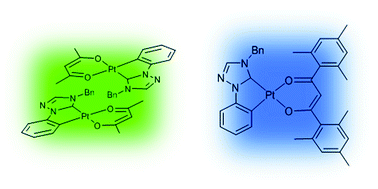
Dalton Trans., 2015,44, 8444-8455
https://doi.org/10.1039/C4DT03613A
Tuning the electronic and phosphorescence properties of blue-emitting iridium(III) complexes through different cyclometalated ligand substituents: a theoretical investigation
A DFT/TDDFT investigation was performed to estimate the OLED performance of six reported and seven newly designed iridium(III) complexes.
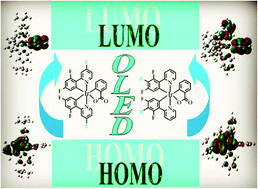
Dalton Trans., 2015,44, 8577-8589
https://doi.org/10.1039/C5DT00048C
Synthesis and characterization of phosphorescent platinum and iridium complexes with cyclometalated corannulene
Novel, emissive Pt(II) and Ir(III) complexes are the first to have measured rates of inversion of cyclometalated corannulene.

Dalton Trans., 2015,44, 8456-8466
https://doi.org/10.1039/C4DT03541K
Iridium(III) N-heterocyclic carbene complexes: an experimental and theoretical study of structural, spectroscopic, electrochemical and electrogenerated chemiluminescence properties
Theoretical and experimental studies of a series of iridium N-heterocyclic carbene complexes.

Dalton Trans., 2015,44, 8564-8576
https://doi.org/10.1039/C4DT03378G
Formylated chloro-bridged iridium(III) dimers as OLED materials: opening up new possibilities
In this study, a series of four formyl-substituted chloro-bridged iridium(III) dimers were prepared.
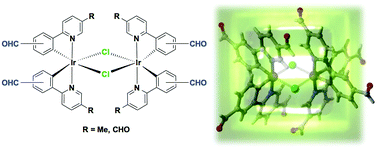
Dalton Trans., 2015,44, 8419-8432
https://doi.org/10.1039/C4DT03127J
Bidentate NHC^pyrozolate ligands in luminescent platinum(II) complexes
The tuning of luminescence from blue to yellow was achieved with platinum complexes containing NHC^pyrozolate and functionalized-phenyl-pyridine or triazole-pyridine ligands.
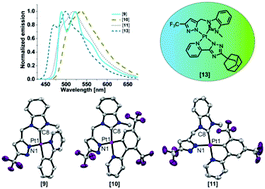
Dalton Trans., 2015,44, 8467-8477
https://doi.org/10.1039/C4DT03651D
Neutral N^C^N terdentate luminescent Pt(II) complexes: their synthesis, photophysical properties, and bio-imaging applications
The reported cyclometallated Pt(II) complexes are characterized by a high cell permeability and a low cytotoxicity. In particular, PtL1Cl shows a very fast internalization kinetics.
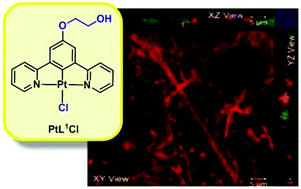
Dalton Trans., 2015,44, 8478-8487
https://doi.org/10.1039/C4DT03165B
Luminescent Pt(II) complexes bearing dual isoquinolinyl pyrazolates: fundamentals and applications
Pt(II) complex [Pt(Lx)2], LxH = 6-t-butyl-1-(3-trifluoromethyl-1H-pyrazol-5-yl) isoquinoline, with three colored morphologies can be interconverted by grinding and/or wetting with solvents.
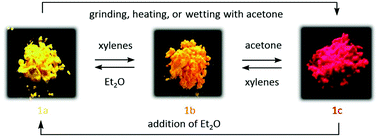
Dalton Trans., 2015,44, 8552-8563
https://doi.org/10.1039/C4DT03028A
Switchable platinum-based tweezers with Pt–Pt bonding and selective luminescence quenching
Molecular tweezers incorporating peripheral platinum salphen complexes and a central chelating terpyridine group have been synthesized and their switching and photophysical response to metal ions studied.

Dalton Trans., 2015,44, 8543-8551
https://doi.org/10.1039/C4DT03230F
Cationic, luminescent cyclometalated iridium(III) complexes based on substituted 2-phenylthiazole ligands
Ten cationic heteroleptic iridium(III) complexes involving substituted phenylthiazole ligands reveal phosphorescence emission in solution.
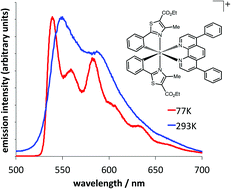
Dalton Trans., 2015,44, 8488-8496
https://doi.org/10.1039/C4DT03054K
Application of three-coordinate copper(I) complexes with halide ligands in organic light-emitting diodes that exhibit delayed fluorescence
Conventional bottom-emitting devices with three-layered structures containing sublimable three-coordinate copper(I) complexes produce bright green luminescence with maximum external quantum efficiencies (EQE) of 18.6–22.5%.
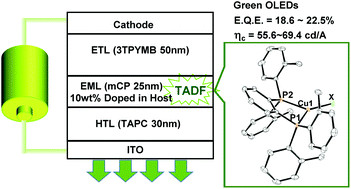
Dalton Trans., 2015,44, 8369-8378
https://doi.org/10.1039/C4DT02853H
Blue phosphorescent N-heterocyclic carbene chelated Pt(II) complexes with an α-duryl-β-diketonato ancillary ligand
Blue phosphorescent Pt(II) complexes that display bright blue emission in the solid state have been obtained employing NHC-based C∧C*-chelate ligands and an α-duryl-β-diketonato ancillary ligand that provides steric blocking to minimize intermolecular interactions.

Dalton Trans., 2015,44, 8433-8443
https://doi.org/10.1039/C4DT03085K
Methylated Re(I) tetrazolato complexes: photophysical properties and Light Emitting Devices
Methylated Re(I) tetrazolato complexes are suitable as phosphors for Light Emitting Devices.
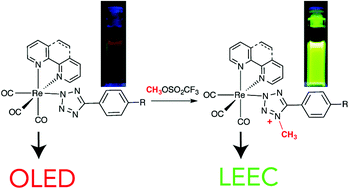
Dalton Trans., 2015,44, 8379-8393
https://doi.org/10.1039/C4DT03228D
Luminescent Re(I) terpyridine complexes for OLEDs: what does the DFT/TD-DFT probe reveal?
The electronic structure and spectroscopic properties of a series of rhenium(I) terpyridine complexes were investigated using density functional theory (DFT) and time dependent density functional theory (TD-DFT) methods.
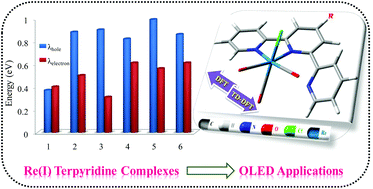
Dalton Trans., 2015,44, 8529-8542
https://doi.org/10.1039/C4DT02917H
A new class of luminescent Cu(I) complexes with tripodal ligands – TADF emitters for the yellow to red color range
A new class of emissive and neutral Cu(I) compounds with tripodal ligands is presented. The complexes were characterized chemically, computationally, and photophysically.
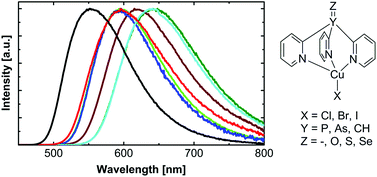
Dalton Trans., 2015,44, 8506-8520
https://doi.org/10.1039/C4DT02631D
Emission energy of azole-based ionic iridium(III) complexes: a theoretical study
Tuning the emission color of azole-based iridium(III) complexes by changing the number and position of nitrogen atoms in the azole ring.

Dalton Trans., 2015,44, 8497-8505
https://doi.org/10.1039/C4DT03046J
A new insight into the chemistry of iridium(III) complexes bearing phenyl phenylphosphonite cyclometalate and chelating pyridyl triazolate: the excited-state proton transfer tautomerism via an inter-ligand PO–H⋯N hydrogen bond
Ir(pdpit)(pppo)(bptz) complex (3) reveals a PO–H–N inter- ligand H-bond from which proton transfer takes place.
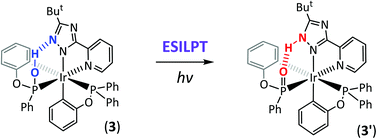
Dalton Trans., 2015,44, 8406-8418
https://doi.org/10.1039/C4DT02922D
Tetraphenylborate versus tetraimidazolylborate as counterions for cationic iridium(III) complexes: enhanced electrochemical stabilities and electroluminescence
Tetraimidazolylborate is first used as the counterion of cationic iridium complexes to improve both electrochemical stabilities and device performance.
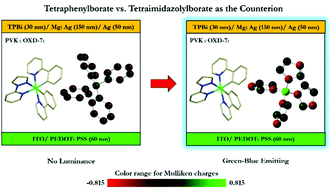
Dalton Trans., 2015,44, 8521-8528
https://doi.org/10.1039/C4DT02830A
A heterotrimetallic Ir(III), Au(III) and Pt(II) complex incorporating cyclometallating bi- and tridentate ligands: simultaneous emission from different luminescent metal centres leads to broad-band light emission
Di- and tri-nuclear metal complexes incorporating Au(III), Ir(III) and Pt(II) units linked via a 1,3,5-triethynylbenzene core.
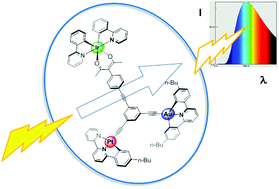
Dalton Trans., 2015,44, 8394-8405
https://doi.org/10.1039/C4DT02761B
About this collection
Inorganic and organometallic components are essential for the creation of functioning light-emitting devices, the development of which is important for reducing world energy use.
This themed issue, guest edited by Dr Eli Zysman-Colman (University of St Andrews), highlights the latest and very best research in this field to the inorganic research community.